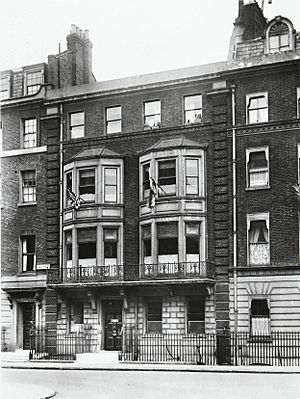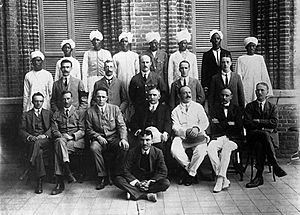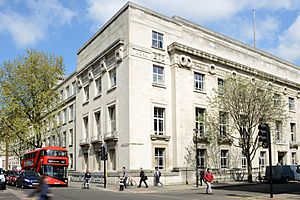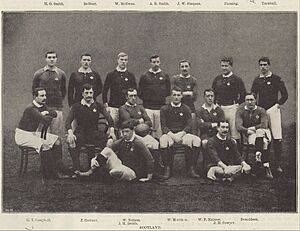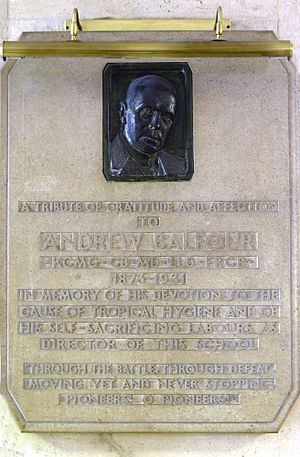Andrew Balfour facts for kids
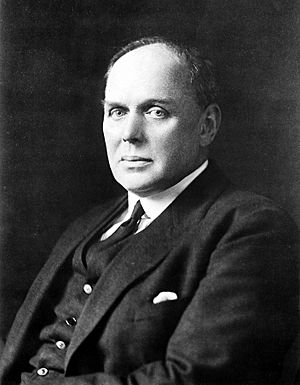 |
|||||||||||||||||||||||||||||||||
| Birth name | Andrew Balfour | ||||||||||||||||||||||||||||||||
|---|---|---|---|---|---|---|---|---|---|---|---|---|---|---|---|---|---|---|---|---|---|---|---|---|---|---|---|---|---|---|---|---|---|
| Date of birth | 21 March 1873 | ||||||||||||||||||||||||||||||||
| Place of birth | Edinburgh, Scotland | ||||||||||||||||||||||||||||||||
| Date of death | 30 January 1931 (aged 57) | ||||||||||||||||||||||||||||||||
| Place of death | Penshurst, England | ||||||||||||||||||||||||||||||||
| School | George Watson's College | ||||||||||||||||||||||||||||||||
| University | Edinburgh University Caius, Cambridge |
||||||||||||||||||||||||||||||||
| Occupation(s) | Medical officer | ||||||||||||||||||||||||||||||||
| Rugby union career | |||||||||||||||||||||||||||||||||
|
|||||||||||||||||||||||||||||||||
Sir Andrew Balfour (born March 21, 1873 – died January 30, 1931) was a Scottish doctor. He became famous for his work in tropical medicine, which deals with diseases found in hot climates. Balfour spent 12 years in Khartoum, Sudan, where he was the main health officer for the city.
Besides his medical work, Sir Andrew Balfour also wrote exciting historical and fantasy novels. Many of these books were published between 1897 and 1903. When he was younger, Balfour was also a talented sportsman. He played rugby union for Cambridge University and even represented the Scottish national team.
Contents
Sir Andrew Balfour's Medical Career
Andrew Balfour was born in Edinburgh, Scotland, on March 21, 1873. He went to George Watson's College and then studied at Edinburgh University.
In 1894, he earned his medical degree (MB, CM) from Edinburgh. He then joined his father's medical practice. A few years later, Balfour went back to school at Gonville and Caius College, Cambridge. Here, he focused on preventing diseases, which became his main interest. He studied typhoid fever and later earned a special degree in public health (D.PH.) in 1897.
He completed his MD degree in Edinburgh in 1898. His research on how dyes pollute rivers won him a student gold medal. In 1900, he earned another degree in Public Health.
Serving in South Africa
In April 1900, Balfour traveled to South Africa to work as a civil surgeon during the Second Boer War. He helped treat soldiers in hospitals and at a camp for typhoid patients. While there, he caught typhoid himself and had to return to England. During his time in South Africa, he met Patrick Manson, a famous expert on parasites. This meeting inspired Balfour to dedicate his life to tropical medicine.
Work in Sudan
In 1902, Balfour became the director of the Wellcome Tropical Research Laboratory in Khartoum, Sudan. He also became the Medical Officer of Health for the city. Within two years, he was advising the Sudanese government on health matters.
In Khartoum, Balfour made a huge difference. He reduced deaths from malaria by 90 percent! He did this by getting rid of mosquito breeding grounds and improving the city's clean water and sanitation systems. His work helped many people.
In 1907, he received an award from the Khedive (the ruler of Egypt and Sudan). He also helped write important reports from the Wellcome Laboratory. In 1911, he co-wrote a review of new discoveries in tropical medicine.
Balfour also helped introduce a special floating laboratory. This lab, given by Dr. Henry Wellcome, allowed scientists to study diseases along the Nile River. This helped them understand blood diseases better. For his important work, he was honored with the Companion of the Order of St Michael and St George in 1912.
Return to Britain and World War I
In 1913, due to health issues in Africa, Balfour returned to Britain. He then founded the Wellcome Bureau of Scientific Research in London. This bureau later became the Wellcome Museum of Medical Science. He also traveled to South America and the West Indies for research that year.
When World War I began, Balfour joined the Royal Army Medical Corps. He became a Lieutenant-Colonel. He served in France, Greece, and Egypt, advising on medical matters. Later, he became a scientific adviser for British forces in East Africa. For his service, he received the Companion of the Order of the Bath in 1918.
Leading the London School of Hygiene
In 1923, Balfour became the Director of the London School of Hygiene & Tropical Medicine. He oversaw the building of a new school. He also served as president of the Royal Society of Tropical Medicine and Hygiene from 1925 to 1927. His important papers are kept in the archives at the London School.
Later in his life, Sir Andrew faced health challenges. In 1930, he was honored as a Knight Commander of the Order of St Michael and St George, becoming Sir Andrew Balfour.
Sir Andrew Balfour's Rugby Union Career
Sir Andrew Balfour was a very active person. As a young man, he was an amateur boxer and a skilled rugby player.
Playing for Clubs and Districts
He first became known as a rugby player while playing for Watsonians. This club was for former students of George Watson's College. He also played for Edinburgh District in 1898.
Playing for Scotland
Balfour was chosen to play for the Scotland national team in 1896. He was 22 years old and played as a forward. His first game was against Wales. Even though Scotland lost, Balfour played in the next two games. Scotland drew against Ireland and then had a great win against England, winning the Calcutta Cup.
The next season (1896-1897), Balfour was studying at Cambridge University. He earned a spot on the Cambridge University team. He played in the famous Varsity Match against Oxford University in 1896, which Cambridge won.
He played one more game for Scotland in 1897 against England. Scotland lost that game, and Balfour did not play for the national team again. However, he continued to play for Cambridge University and won another Varsity Match in 1897.
Rugby Administration
After he stopped playing, Balfour stayed involved with rugby. He supported London Scottish F.C. and became a national selector for the Scottish Rugby Union. In the 1929-1930 season, he became the Vice-President of the Scottish Rugby Union. The next season, he became President, but he sadly passed away before finishing his term.
Sir Andrew Balfour's Literary Career
Besides his medical writings, Sir Andrew Balfour was also a talented writer of adventure novels. In 1897, while still at Cambridge, his first novel, By Stroke of Sword, was published.
Balfour's novels were mostly historical adventures. They were often set in Scotland and sometimes connected to his medical background. He wrote three historical novels:
- By Stroke of Sword was about Mary, Queen of Scots.
- To Arms! was about the Jacobite rising of 1715.
- Vengeance Is Mine was about Napoleon during the Hundred Days period.
His last novel, The Golden Kingdom (1903), was a "lost race" story. This type of story is about discovering a hidden civilization. It was inspired by famous adventure writers like H. Rider Haggard and Robert Louis Stevenson.
Written Works
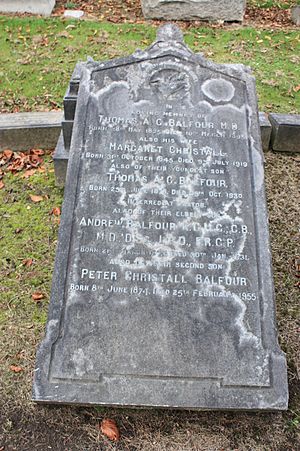
Medical Books
- Medicine, Public Health and Preventive Medicine (with C. J. Lewis, 1902)
- Memoranda on Medical Diseases in Tropical and Sub-Tropical Areas (1916)
- War Against Tropical Disease (1920)
- Reports to the Health Committee of the League of Nations on Tuberculosis and Sleeping Sickness in Equatorial Africa (1923)
- Health Problems of the Empire (with H. H. Scott, 1924)
Novels
- By Stroke of Sword (1897)
- To Arms! (1898) Available at OpenLibrary
- Vengeance is Mine (1899) Available at OpenLibrary
- Cashiered and Other War Stories (1902)
- The Golden Kingdom (1903) Available at OpenLibrary
Death and Family
Sir Andrew Balfour passed away on January 30, 1931. He was survived by his wife and two sons.
He is buried in Grange Cemetery in Edinburgh, alongside his parents. His uncle was John Hutton Balfour, a famous botanist.


